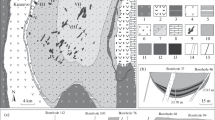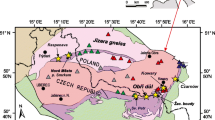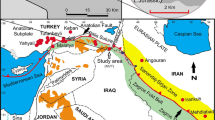Abstract—
The paper presents results of petrological and geochemical studies of sulfide-bearing rocks from a bottom apophysis in the central part of the Yoko-Dovyren massif, northern Transbaikalia, Russia. It is composed of plagioperidotite and was sampled in a bulge up to 300 m thick throughout the whole vertical section, from its upper to lower contact. The observed diversity of sulfide-bearing rocks is subdivided into four types: (1) picrodolerite with droplet-shaped sulfides, (2) olivine gabbronorite with sulfides varying from droplet-shaped to irregular globules, (3) olivine gabbronorite with larger globules and patchy net-textured domains, and (4) net-textured ores. These varieties occur in the basal zone of the apophysis, in the interval up to 30 m inward from the lower contact. Petrographic features of these rocks correspond to olivine ortho- and mesocumulates, with the only exception of the quenched picrodolerite with an ophitic groundmass. The association of sulfides (pyrrhotite, chalcopyrite, pentlandite, and cubanite) has a pretty little varying composition, except only a relative decrease in the proportion of chalcopyrite in samples with more than 5% sulfides. The results of X-ray computed tomography show an increase in the sulfide connectivity in the rocks (from 25 to 95%) with increasing sulfide abundance. These characteristics, supported by visualized 3D models, allowed us to identify a morpho-structural trend tended from the rocks with sulfide droplets to the net-textured ores. The first ever data were obtained on the chemostratigraphy (PGE and tellurium) of rocks composing this apophysis. Covariations of Au, Pt and Pd with S and Te indicate that the precious metals have a single sulfide precursor. The 100%-sulfide compositions calculated for these rocks indicate that the most primitive and PGE rich sulfides correspond to droplets it the lowerest part of the apophysis, whereas the net-textured ores are depleted in these elements. The geochemical estimates are supported with COMAGMAT-5 modeling which made it possible to calculate the average Au, PGE, and Te contents in the protosulfide melt (in ppm): 2.9 Au, 14.4 Pt, 25.1 Pd, and 44.3 Te. Results of the geochemical studies of different fragments of the net-textured ores reveal a heterogeneity in the form of domains relatively enriched in copper, PGE, and tellurium, whose characteristic size is a few dozen centimeters. This can be considered as a signature of the porous migration and accumulation of the crystallization products of the original sulfide liquid at the subsolidus stage of cooling down the ore-bearing cumulates.










Similar content being viewed by others
Notes
An is Ca/(Ca + Na + K) × 100.
mg# = Mg/(Mg + Fetot) × 100.
cr# = Cr/(Cr + Fetot) × 100.
\(D_{i}^{{{{Sf} \mathord{\left/ {\vphantom {{Sf} {Melt}}} \right. \kern-0em} {Melt}}}}\) = 1000 (Cu), 5/36 × 105 (Pd), 1/56 × 106 (Pt), 1.12 × 105 (Au), and 9000 (Te).
REFERENCES
A. A. Ariskin, E. G. Konnikov, L. V. Danyushevsky, E. V. Kislov, G. S. Nikolaev, D. A. Orsoev, G. S. Barmina, and K. A. Bychkov, “The Dovyren intrusive complex: Problems of petrology and Ni sulfide mineralization,” Geochem. Int. 47 (5), 425–453 (2009).
A. A. Ariskin, L. V. Danyushevsky, K. A. Bychkov, A. W. McNeill, G. S. Barmina, and G. S. Nikolaev, “Modeling solubility of Fe–Ni sulfides in basaltic magmas: The effect of Ni in the melt,” Econ. Geol. 108 (8), 1983–2003 (2013).
A. A. Ariskin, E. G. Konnikov, L. V. Danyushevsky, Yu. A. Kostitsyn, S. Meffre, G. S. Nikolaev, A. W. McNeill, E. V. Kislov, and D. A. Orsoev, “Geochronology of the Dovyren intrusive complex, northwestern Baikal area, Russia, in the Neoproterozoic,” Geochem. Int. 51 (11), 859–875 (2013).
A. A. Ariskin, E. V. Kislov, L. V. Danyushevsky, G. S. Nikolaev, M. Fiorentini, S. Gilbert, K. Goemann, and A. Malyshev, “Cu–Ni-PGE fertility of the Yoko-Dovyren layered massif (Northern Transbaikalia, Russia): thermodynamic modeling of sulfide compositions in low mineralized dunites based on quantitative sulfide mineralogy,” Mineral. Deposita 51 (8), 993–1011 (2016).
A. A. Ariskin, K. A. Bychkov, and G. S. Nikolaev, “Modeling of trace-element composition of sulfide liquid in a crystallizing basalt magma: development of the R-Factor concept,” Geochem. Int. 55(5), 465–473 (2017).
A. A. Ariskin, G. S. Nikolaev, L. V. Danyushevsky, M. L. Fiorentini, E. V. Kislov, and I. V. Pshenitsyn, “Geochemical evidence for the fractionation of iridium group elements at the early stages of crystallization of the Dovyren magmas (northern Baikal area, Russia), Russ. Geol. Geophys. 59 (5), 459–471 (2018).
A. A. Ariskin, K. A. Bychkov, G. S. Nikolaev, and G. S. Barmina, “The COMAGMAT-5: Modeling the effect of Fe-Ni sulfide immiscibility in crystallizing magmas and cumulates,” J. Petrology 59 (2), 283–298 (2018a).
A. Ariskin, L. Danyushevsky, G. Nikolaev, E. Kislov, M. Fiorentini, A. McNeill, Yu. Kostitsyn, K. Goemann, S. Feig, and A. Malyshev, “The Dovyren intrusive complex (Southern Siberia, Russia): insights into dynamics of an open magma chamber with implications for parental magma origin, composition, and Cu–Ni-PGE fertility,” Lithos 302, 242–262 (2018b).
A. A. Ariskin G. S. Nikolaev, L. V. Danyushevsky, M. Fiorentini, E. V. Kislov, and I. V. Pshenitsyn, “Genetic interpretation of the distribution of PGE and chalcogens in sulfide-mineralized rocks from the Yoko-Dovyren layered intrusion,” Geochem. Int. 56 (13), 1322–1340 (2018c).
A. A. Ariskin, L. V. Danyushevsky, M. L. Fiorentini, G. S. Nikolaev, E. V. Kislov, I. V. Pshenitsyn, V. O. Yapaskurt, and S. N. Sobolev, “Petrology, geochemistry, and origin of sulfide-bearing and PGE-mineralized troctolites from the Konnikov zone in the Yoko-Dovyren layered intrusion,” Russ. Geol. Geophys. 61 (5–6), 611–633 (2020).
A. A. Ariskin, I. V. Pshenitsyn, E. O. Dubinina, S. A. Kossova and S. N. Sobolev, “Sulfur isotope composition of olivine gabbronorites from a mineralized apophysis of the Yoko-Dovyren intrusion, Northern Transbaikalia, Russia,” Petrology 29 (6), 597–613. (2021).
L. M. Baburin, Geological Structure and Metal Potential of the Dovyren Mafic–Ultramafic Massif. Final Report on the Results of Prospecting Works of the Baikalian Complex Team for 1960–63 (Buryatsk. Geol. Upravl., Uland-Ude, 1964).
D. R. Baker and R. Moretti, “Modeling the solubility of sulfur in magmas: a 50-year old geochemical challenge,” Rev. Mineral. Geochem. 73, 167–213 (2011).
S.-J. Barnes and P. C. Lightfoot, “Formation of magmatic nickel-sulfide ore deposits and processses affecting their copper and platinum-group element contents,” Econ. Geol. 100, 179–213 (2005).
S.-J. Barnes and E. M. Ripley, “Highly siderophile and strongly chalcophile elements in magmatic ore deposits,” Rev. Mineral. Geochem. 81 (1), 725–774 (2016).
S.-J. Barnes, A. R. Cruden, N. Arndt, and B. M. Saumur, “The mineral system approach applied to magmatic Ni–Cu–PGE sulphide deposits,” Ore Geol. Rev. 76 (94), 296–316 (2016).
S. J. Barnes, J. E. Mungall, M. Le Vaillant, B. Godel M. C. Lesher, D. Holwell, C. Peter, P. C. Lightfoot, N. Krivolutskaya, and B. Wei, “Sulfide–silicate textures in magmatic Ni–Cu-PGE sulfide ore deposits: Disseminated and net-textured ores,” Am. Mineral. 102 (3), 473–506 (2017).
S. J. Barnes, M. Le Vaillant, B.Godel, and C. M. Lesher, “Droplets and bubbles: solidification of sulphide-rich vapour-saturated orthocumulates in the Norilsk–Talnakh Ni–Cu–PGE ore-bearing intrusions,” J. Petrol. 60 (2), 1–31 (2019).
I. H. Campbell and A. J. Naldrett, “The influence of silicate:sulfide ratios on the geochemistry of magmatic sulfides,” Econ. Geol. 74 (6), 1503–1506 (1979).
H.-Y. Chung and J. E. Mungall, “Physical constraints on the migration of immiscible fluids through partially molten silicates, with special reference to magmatic sulfide ores,” Earth Planet. Sci. Lett. 286 (1–2), 14–22 (2009).
C. J. Duran, S-J. Barnes, P. Pleše, M. Kudrna Prašek, M. L. Zientek, and P. Pagé, “Fractional crystallization-induced variations in sulfides from the Noril’sk-Talnakh mining district (polar Siberia, Russia),” Ore Geol. Rev. 90, 326–351 (2007).
M.-A. Fortin, J. Riddle, Y. Desjardins-Langlais, and D. R. Baker, “The effect of water on the sulfur concentration at sulfide saturation (SCSS) in natural melts,” Geochim. Cosmochim. Acta 160, 100–116 (2015).
A. D. Genkin V. V. Distler, G. D. Gladyshev, et al., Sulfide Copper–Nickel Ores of the Norilsk Deposit (Nauka, Moscow, 1981) [in Russian].
M. N. Godlevsky, Traps and Ore-Bearing Intrusions of the Norilsk District (Gosgeoltekhizdat, Moscow, 1959) [in Russian].
D. A. Holwell and I. McDonald, “A review of the behavior of platinum group elements within natural magmatic sulfide ore systems. The importance of semimetals in governing partitioning behavior,” Plat. Met. Rev. 54 (1), 26–36 (2010).
L. N. Kacharovskaya, Extended Abstract of Candidate’s Dissertation in Geology and Mineralogy (Ulan-Ude, 1986) [in Russian].
E. S. Kiseeva and B. J. Wood, “The effects of composition and temperature on chalcophile and lithophile element partitioning into magmatic sulphides,” Earth Planet. Sci. Lett. 424, 280–294 (2015).
E. V. Kislov, Yoko-Dovyren Layered Massif (Buryat. Nauchn. Ts., Ulan-Ude, 1998) [in Russian].
E. G. Konnikov, Differentiated Precambrian Ultramafic–Mafic Complexes Transbaikalia (Nauka, Novosibirsk, 1986) [in Russian].
E. V. Koptev-Dvornikov and D. M. Khvorov, “Estimation of crystallization proportions and the equilibrium/disequilibrium of quench experiments in the basite systems,” Geochem. Int. 49 (1), 13–30 (2011).
D. V. Korost, A. A. Ariskin, I. V. Pshenitsyn and A. N. Khomyak, “X-Ray computed tomography as a method for reproducing 3D characteristics of sulfides and spinel disseminated in plagiodunites from the Yoko-Dovyren Intrusion,” Petrology 27 (4), 370–385 (2019).
N. A. Krivolutskaya, Siberian Traps and Pt–Cu–Ni Deposits in the Noril’sk Area (Springer, Heidelberg–New York–Dordrecht–London, 2016)
I. V. Kubrakova, S. N. Nabiullina, and O. A. Tyutyunnik, “Au and PGE determination in geochemical materials: experience in applying spectrometric techniques,” Geochem. Int. 58 (5), 377-390 (2020).
A. P. Likhachev, Platium–Copper–Nickel and Platinum Deposits (Eslan, Moscow, 2006) [in Russian].
W. D. Maier, “Platinum-group element (PGE) deposits and occurrences: mineralization styles, genetic concepts, and exploration criteria,” J. Afr. Earth Sci. 41 (3), 165–191 (2005).
J. E. Mungall and J. M. Brenan, “Partitioning of platinum-group elements and Au between sulfide liquid and basalt and the origins of mantle-crust fractionation of the chalcophile elements,” Geochim. Cosmochim. Acta. 125, 265–289 (2014).
A. J. Naldrett, Magmatic Sulfide Deposits: Geology, Geochemistry and Exploration (Springer-Verlag, Heidelberg–Berlin, 2004).
G. V. Novikov, Pyrrhotites: Crystalline and Magnetic Structure, Phase Transformations (Nauka, Moscow, 1988) [in Russian].
D. A. Orsoev, A. S. Mekhonoshin, S. V. Kanakin, R. A. Badmatsyrenova, and E. A. Khromova, “Gabbro–peridotite sills of the Late Riphean Dovyren plutonic complex (northern Baikal region),” Russ. Geol. Geophys. 59 (5), 472–485 (2018).
H. M. Prichard, D. Hutchinson, and P. C. Fisher, “Petrology and crystallization history of multiphase sulfide droplets in a mafic dike from Uruguay: implications for the origin of Cu–Ni–PGE sulfide deposits,” Econ. Geol. 99 (2), 365–376 (2004).
I. V. Pshenitsyn, A. A. Ariskin, G. S. Nikolaev, E. V. Kislov, D. V. Korost, V. O. Yapaskurt and S. N. Sobolev, “Morphology, mineralogy, and composition of sulfide droplets in picrodolerite from a near-bottom apophysis of the Yoko-Dovyren layered intrusion,” Petrology 28 (3), 246–262 (2020).
V. A. Rad’ko, Model of dynamic differentiation of intrusive traps of the Siberian Platform, Geol. Geofiz., No. 11, 19–27 (1991).
E. M. Ripley and C. Li, “Sulfide saturation in mafic magmas: is external sulfur required for magmatic Ni-Cu-(PGE) ore genesis?,” Econ. Geol. 108 (1), 45–58 (2013).
V. V. Ryabov, A. Ya. Shevko, and M. P. Gora, Magmatic Rocks of the Noril’sk District. Volume 1. Perology of Traps (Nonparel’, Novosibirsk, 2011) [in Russian].
S. F. Sluzhenikin, V. V. Distler, O. A. Dyuzhikov, et al., “Low-sulfide platinum mineralization in the Norilsk differentiated intrusions,” Geol. Rudn. Mestorozhd. 36 (3), 195–217 (1994).
E. M. Spiridonov, “Ore-magmatic systems of the Noril’sk ore field,” Russ. Geol. Geophys. 51 (9), 1059–1077 (2010).
E. M. Spiridonov, D. A. Orsoev, A. A. Ariskin, G. S. Nikolaev, E. V. Kislov, N. N. Korotaeva, and V. O. Yapaskurt, “Hg-and Cd-bearing Pd, Pt, Au, and Ag minerals in sulfide-bearing mafic and ultramafic rocks of the Yoko–Dovyren intrusion in the Baikalides of the northern Baikal Area,” Geochem. Int. 57 (1), 42–55 (2019).
L. A. Taylor and L. W. Finger, “Structural refinement and composition of mackinawite,” Carn. Inst. Washington Geophysic. Lab. Annual Rep. 69, 318–322 (1970).
N. D. Tolstykh, D. A. Orsoev, A. P. Krivenko, and A. E. Isokh, Noble Metal Mineralization in the Layered Ultramafic–Mafic of the Southern Siberian Platform (Parallel’, Novosibirsk, 2008) [in Russian].
A. V. Vishnevskiy and M. V. Cherdantseva, “Merenskyite and other precious metal minerals in sulfide blebs from the Rudniy ultramafic-mafic intrusion, northwest Mongolia,” Can. Mineral. 54(2), 519–535 (2016).
Z. Wang, Z. Jin, J. E. Mungall, and X. Xiao, “Transport of coexisting Ni-Cu sulfide liquid and silicate melt in partially molten peridotite,” Earth Planet Sci. Lett. 536, 116–162 (2020).
ACKNOWLEDGMENTS
The authors thank E.M Spiridonov for help with the fieldwork and consultations on the mineralogical study. A.N. Khomyak is thanked for practical recommendations on processing CT data. The composition of mineral phases was studied at the Laboratory for Analysis of Materials at a High Spatial Resolution at the Department of Petrology, Moscow State University (analysts V.O. Yapaskurt and N.N. Korotaeva). Special thanks are due to M.A. Yudovskaya (Institute of the Geology of Ore Deposits, Petrography, Mineralogy, and Geochemistry, Russian Academy of Sciences) and O.A. Lukanin (Vernadsky Institute of Geochemistry and Analytical Chemistry, Russian Academy of Sciences) for valuable comments on the content of the manuscript.
Funding
Samples for the mineralogical study were prepared under a government-financed research project for Vernadsky Institute of Geochemistry and Analytical Chemistry, Russian Academy of Sciences. This study was financially supported by the Russian Foundation for Basic Research, project no. 16-17-10129.
Author information
Authors and Affiliations
Corresponding author
Ethics declarations
The authors declare that they have no conflict of interest.
Additional information
Translated by E. Kurdyukov
Rights and permissions
About this article
Cite this article
Pshenitsyn, I.V., Ariskin, A.A., Nikolaev, G.S. et al. Geochemistry and Petrology of Protosulfide Melts in an Ore-Bearing Apophysis of the Yoko-Dovyren Intrusion. Geochem. Int. 60, 235–255 (2022). https://doi.org/10.1134/S0016702922030065
Received:
Revised:
Accepted:
Published:
Issue Date:
DOI: https://doi.org/10.1134/S0016702922030065




